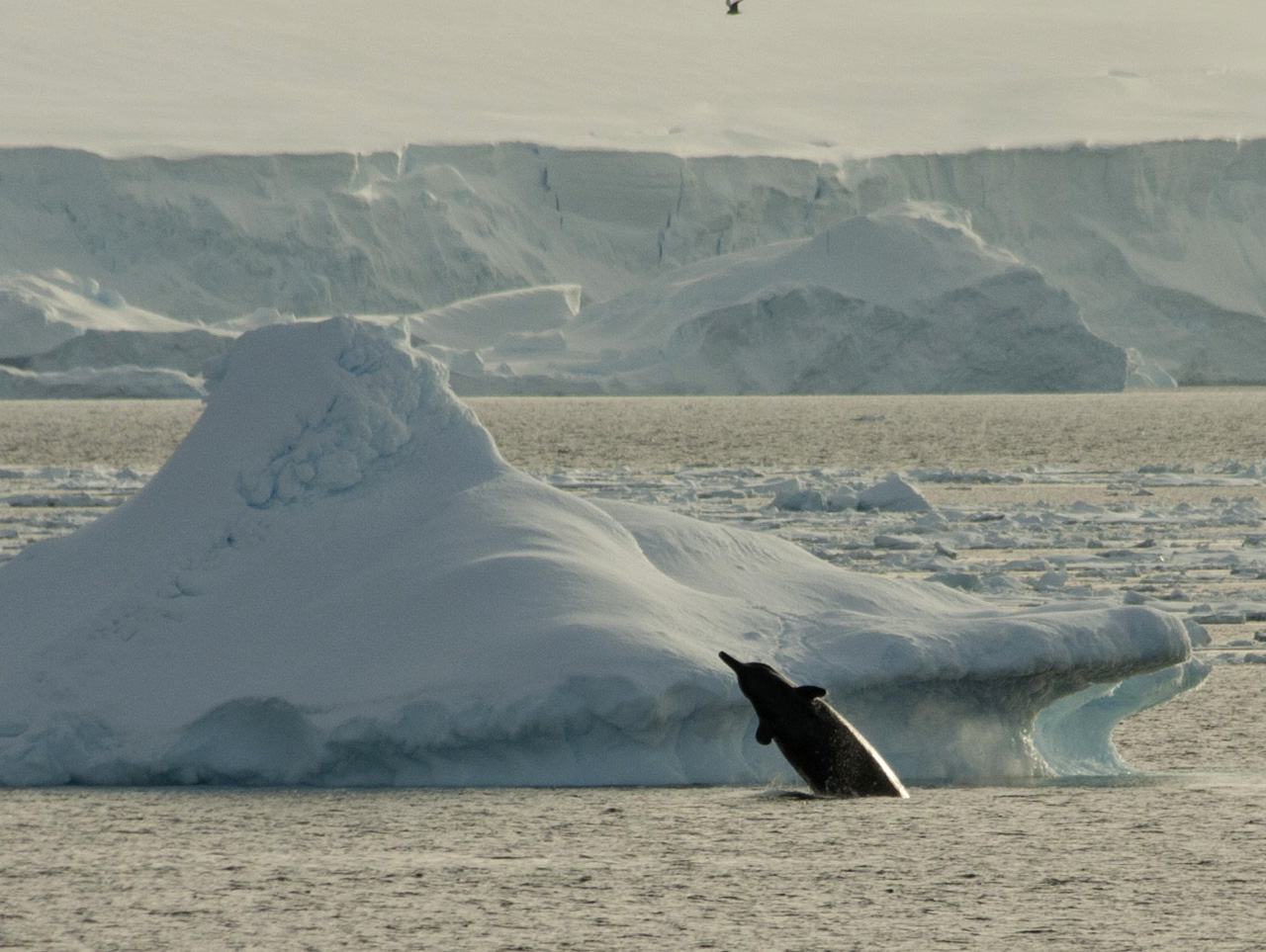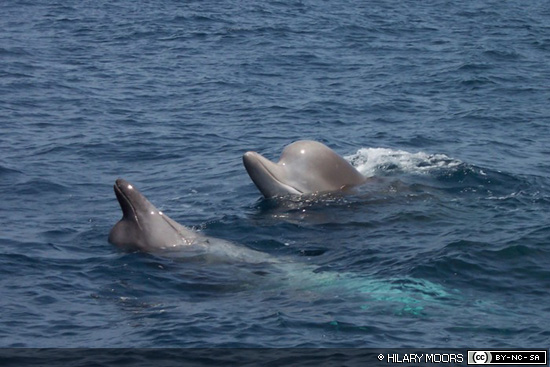Translations:AY Honors/Cetaceans/Answer Key/38/en
Giant Beaked Whale/Arnoux and Baird’s Beaked Whales (Berardius)
Where found: Arnoux’s beaked whale Berardius arnuxii lives in cold Southern Hemisphere waters and Baird’s beaked whale Berardius bairdii is found the cold temperate waters of the North Pacific.
Description: You would not be able to see the differences between Arnoux and Baird’s beaked whales except that they live on opposite ends of the world. They grow to 10–12 m in length and up to 14,000 kg (31,000 lb). They have very long prominent beak, even by beaked whale standards. The lower jaw is longer than the upper and the front teeth are visible even when the mouth is fully closed. The melon is particularly bulbous. The body shape is slender - the girth is only 50% of length. The body is uniformly coloured and a particular individual's colour may be anything from light grey through to black. The flippers are small, rounded and set towards the front of the body. The dorsal fin similarly is small and rounded and set about three-quarters of the way along the back. Adult males and females of both species pick up numerous white linear scars all over the body as they age and may be a rough indicator of age.
- B. arnuxii is known as Arnoux's beaked whale, southern four-toothed whale, southern beaked whale, New Zealand beaked whale, southern giant bottlenose whale, and southern porpoise whale.
- B. bairdii is known as Baird's beaked whale, northern giant bottlenose whale, North Pacific bottlenose whale, giant four-toothed whale, northern four-toothed whale, and North Pacific four-toothed whale.
Northern and Southern Bottlenose Whales (Hyperoodon)
Where found: Northern bottlenose whale are found in the North Atlantic Ocean and is found in cool and subarctic deep waters such as the Davis Strait, the Labrador Sea, the Greenland Sea and the Barents Sea and as far south as Cape Verde Islands. Southern bottlenose whales are probably the most abundant whale in Antarctic waters.
Description: These sister species are fairly rotund with an extremely bluff melon. The beak is long and white on males but grey on females. The dorsal fin is relatively small at 30–38 centimetres (12–15 in) and set behind the middle of the back. It is falcate (sickle-shaped) and usually pointed. The Northern species measures 9.8 metres (32 ft) in length when physically mature. The back is mid-to-dark grey, with a lighter underside. The Southern bottlenose whale smaller growing to 7.5 m (25 ft) in length when physically mature. The back is light-to-mid grey, also with a lighter underside. Males are about 25% larger than females. These bottlenose whales live up to 37 years. Weight estimates are hard to come by. For the northern bottlenose whale, 5,800–7,500 kilograms (12,800–16,500 lb) is given somewhat consistently, while the smaller and less studied southern species will be lighter. The bottlenose whales are some of the deepest diving mammals known, reaching depths of 1453 m (4767 ft) The whales feed on squid, sea cucumbers, herring, cuttlefish, sea stars and other benthic invertebrates.Video Northern Bottlenose Whale
Cuvier's beaked whale (Ziphius cavirostris)
Where found: Open ocean worldwide except in the Arctic and Southern oceans.
Description: The Cuvier's beaked whale or goose-beaked whale is the most widely distributed of all the beaked whales. Individuals commonly have white scars and patches caused by cookiecutter sharks. It prefers depth greater than 1,000 m (3,300 ft) and avoids ships, it is still one of the most frequently spotted beaked whales. The maximum known depth reached by the Cuvier's beaked whale is 2,992 metres (9,816 ft), or 1.8 miles, making it the deepest-diving mammal. The species name comes from Greek xiphos, "sword", and Latin cavus, "hollow" and rostrum, "beak", referring to the indentation on the head in front of the blowhole. The body of Cuvier's beaked whale is robust and cigar-shaped, similar to those of other beaked whales and can be difficult to distinguish from many of the mesoplodont whales at sea. Males and females are the same size up to about 5–7 m (16–23 ft) in length 2,500 kg (5,500 lb). The dorsal fin is curved, small and located two-thirds of the body length behind the head. Flippers are equally small and narrow and can be tucked into pockets in the body wall, presumably to prevent drag while swimming. Like other beaked whales, its flukes are large and lack the medial notch found in all other cetaceans. The head is short with a small, poorly defined rostrum and a gently sloping melon. A pair of throat grooves allow the whale to expand this region when sucking in its prey. Cuvier's beaked whale has a short beak in comparison with other species in its family, with a slightly bulbous melon. The melon is white or creamy in color and a white strip runs back to the dorsal fin about two-thirds of the way along the back. The rest of the body color varies by individual: some are dark grey; others a reddish-brown. The dorsal fin varies in shape from triangular to highly falcate, whilst the fluke is about one-quarter the body length. They live for forty years. Culvers beaked whale



